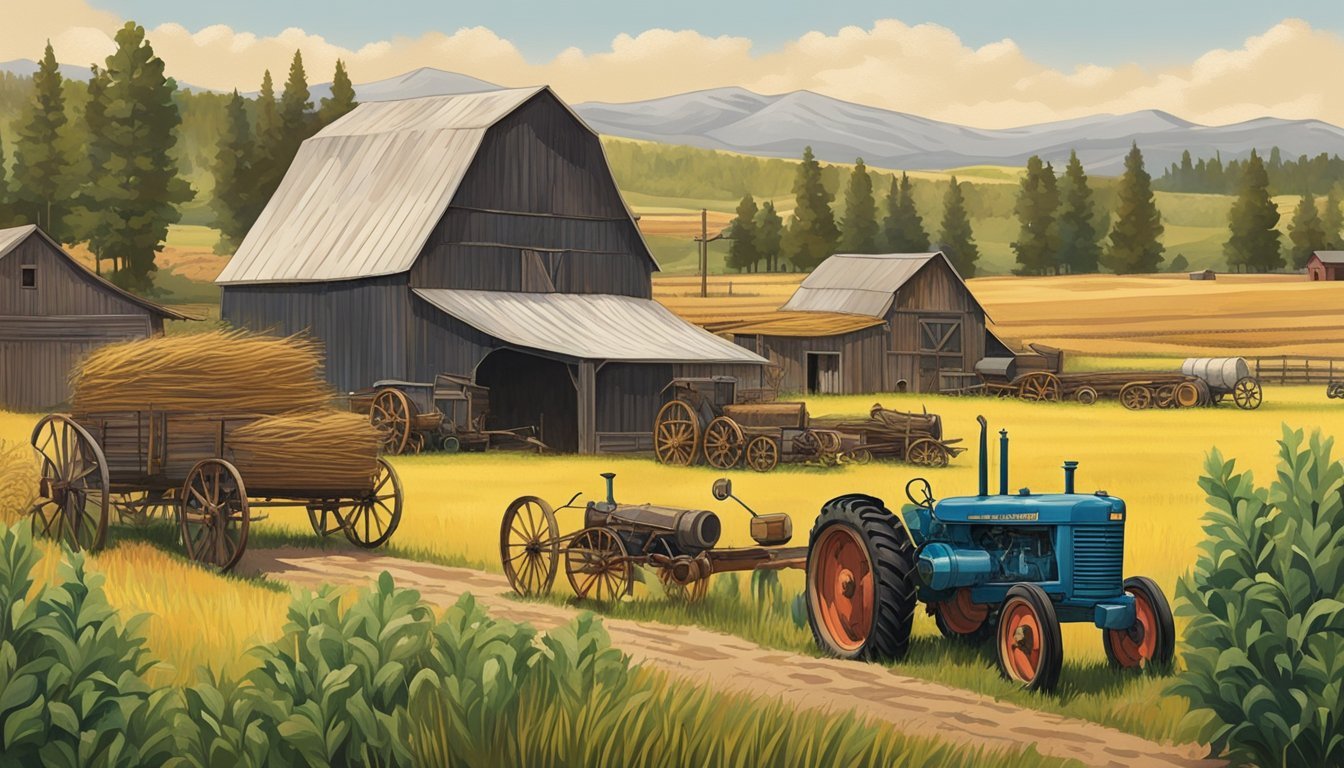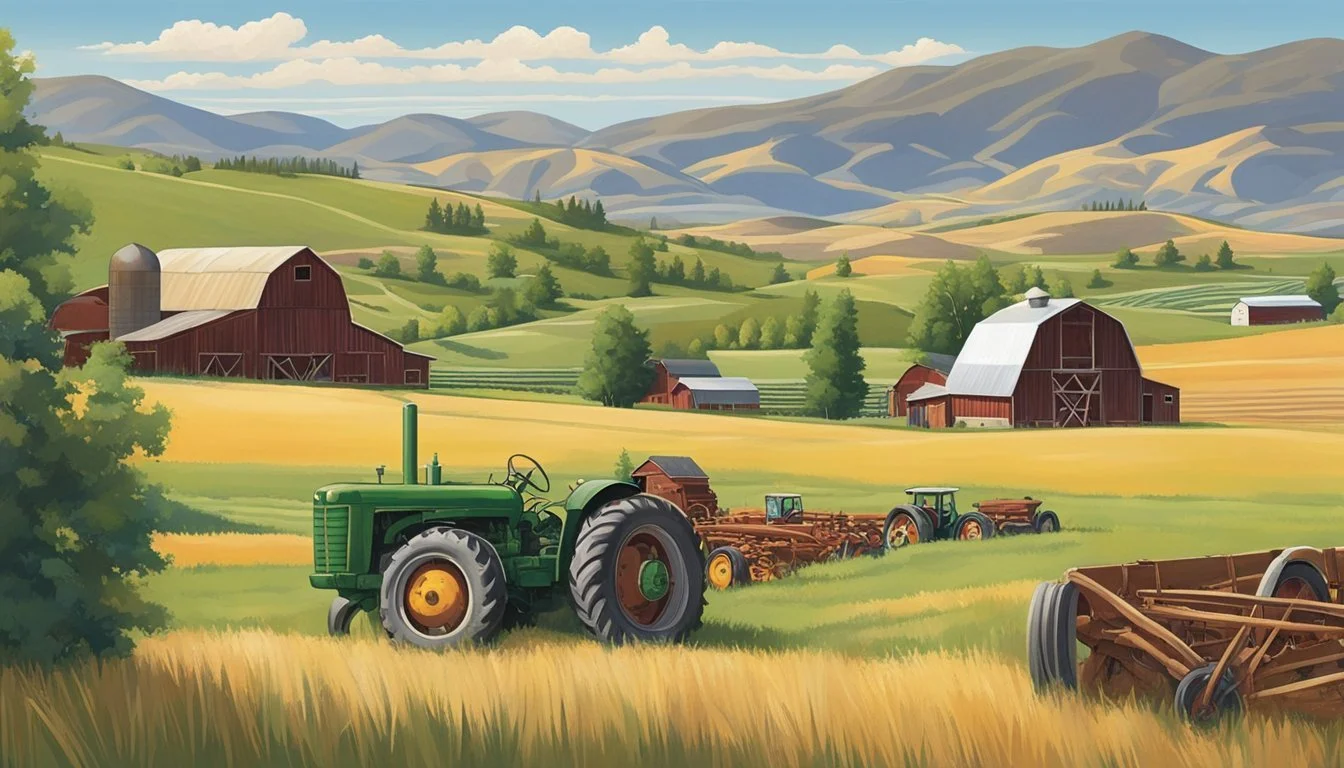Historical Farms and Agricultural Museums in Idaho
A Guide to Rural Heritage Tours
Idaho's landscape is rich with the history of farming and ranching, a testament to the state's long-standing connection to agriculture. To understand the role farming has played in the development of the region, several museums and historical societies have dedicated themselves to preserving this cultural heritage. They tell the story of how agriculture shaped the social and economic fabric of Idaho. By doing so, they offer visitors a chance to step back in time and appreciate the agricultural practices and innovations that have taken place over the years.
The Idaho Farm & Ranch Museum, operated by the Jerome County Historical Society, is an example of such preservation efforts. This museum commemorates the agricultural milestones of the Magic Valley region by showcasing historical buildings, a barn, a church, and a rich collection of farm equipment. Through these exhibits, the museum educates the public on the rigors and evolution of farm life in Idaho.
Complementing personal experiences of farm history, the Idaho Century Farm and Ranch Program recognizes families who have maintained farming and ranching operations on the same land for 100 years or more. This initiative underscores the commitment and resilience of Idaho's agricultural community over the past century. Both of these organizations contribute to the collective understanding of Idaho's agricultural roots, offering a comprehensive overview of the state's storied agrarian past.
Historical Background of Idaho Farms
Idaho's agricultural history is as rich and fertile as the soil that has supported its farms for generations. It's a tapestry of tradition and innovation that has made Idaho not only a key player in the agricultural scene of the Western United States but also an emblem of the culture and progress of the state.
The Advent of Agriculture in Idaho
Agriculture has been the cornerstone of Idaho since the state was settled. The region's agriculture began to thrive with the introduction of irrigation, transforming Idaho into a significant farming state. Idaho’s agriculture sector quickly became the foundation of its economy and a way of life for its inhabitants.
Jerome County's Farming Genesis
In the heart of the Magic Valley, Jerome County witnessed the birth of an agricultural movement that would influence the entire region. This area, celebrated at the Idaho Farm and Ranch Museum, symbolizes a rich farming heritage, beginning with the early 20th-century settlement and the subsequent boom in agricultural development due to an influx of irrigation projects.
The Evolution of Farming Practices
Over the years, Idaho has seen its farming practices undergo significant change, moving from the labor-intensive methods of early settlers to the technologically driven, efficient, and environmentally conscious methods of today. Thanks to institutions like the Idaho State Historical Society, these advances are documented and celebrated, showcasing farms that have been maintained for over a century and represent the enduring legacy of Idaho agriculture in the West and the United States.
Idaho's Agricultural Museums
Idaho's rich agricultural heritage is celebrated and preserved through several dedicated museums and exhibits. These institutions provide a window into the state's farming history and culture.
Jerome County Historical Society
The Idaho Farm and Ranch Museum, managed by the Jerome County Historical Society, offers visitors a detailed look at the Magic Valley's agricultural past. This outdoor museum in Jerome County features historical buildings, a barn, a church, and a collection of farm equipment.
Caldwell's Heritage Museums
Caldwell, though specific museums were not listed in the provided data, is known to have a storytelling tradition through its local historical sites. Agricultural exhibits here likely focus on the farming practices and developments that have shaped the region's agrarian lifestyle.
Boise's Agricultural Exhibits
Boise, Idaho's capital, presents a series of agricultural exhibits that underscore the state's bond with farming. Boise's historical museums probably include displays on agricultural practices, advancements, and the impact on the local economy, reflecting the region's connection with its rural roots.
McCall's Ranch Museum
In McCall, the heritage of ranching is captured and displayed, possibly through preserved cabins and artifacts. These exhibits could include items on the National Register of Historic Places, showcasing the evolution of ranching in the area.
Each museum and exhibit shares a unique part of Idaho's agricultural story, from Jerome's farming equipment to Boise's interpretive displays, offering comprehensive insight into the state's agrarian culture.
Visiting Farms and Museums
Idaho’s rich agricultural history is showcased in its historical farms and museums, which offer a variety of experiences for visitors. Exploring these sites provides a unique glimpse into the state's farming heritage and its evolution over time.
Operating Hours and Entry Fees
Idaho Farm and Ranch Museum: Admission to the museum is free, although donations are welcome to support their efforts. Visitors should check the Idaho Farm & Ranch Museum website for the most current hours of operation, as they can vary by season and availability of volunteers.
Hours:
Typical hours: Open seasonally, May through September
Extended hours may be available by advance request for special tours.
Location Standard Hours Fee Note Idaho Farm and Ranch Museum May-Sept, Hours Vary Free (Donations Accepted) Special tours may require advance booking.
Travel Tips for Visitors
Traveling in Idaho, specifically to historical farms and museums, involves a mix of adventure and relaxation. Driving is a common mode of transportation, with many destinations like the Idaho Farm and Ranch Museum being easily accessible from major roadways such as I-84. When planning a visit:
Check weather conditions as Idaho's weather can be variable.
Confirm availability of the sites since some museums may have seasonal hours.
Prepare for the outdoors if you plan to engage in farm-related activities.
Events and Programs
The museums host a range of events and programs throughout the year to celebrate Idaho's agricultural history. These can include crafting demonstrations, historical reenactments, and harvest festivals. To make the most of these programs:
Explore ahead: Visit the respective museum’s website for upcoming events and programs.
Plan for participation: Some events may require visitors to actively participate or play a role in the experience.
Book in advance: For special events, ensure to register or purchase tickets in advance to guarantee participation.
Visitors can enrich their Idaho adventures by engaging with the state's historical farms and museums—fostering a deeper connection with the heart of Idaho's agricultural community.
Exploring the Broader Impact
In Idaho, the significance of agricultural heritage is multifaceted, influencing not only the economy but also the sociocultural fabric of the state.
Agriculture on Idaho's Economy
Agriculture is a cornerstone of Idaho's economy, representing a significant sector that contributes to the overall financial stability and growth of the state. The Idaho State Historical Society's Century Farm and Ranch Program highlights this economic impact by documenting the continued success of farms that have been in operation for more than a century. Today, Idaho boasts over 24,500 farms, which are vital for producing a diverse array of crops and livestock, reinforcing the state's economic infrastructure.
Key Economic Contributions:
Crops: Potatoes, grains, sugar beets, and legumes.
Livestock: Dairy, cattle, and sheep industries.
The technological advancements in agriculture have propelled the dairy sector to producing 400% more milk than seven decades ago, illustrating the sector's evolution and sustained economic clout.
The Sociocultural Role of Farms
The culture and history of Idaho are inextricably linked to its farms and agricultural practices. Museums like the Idaho Farm & Ranch Museum play a pivotal role in recounting the agricultural saga of Central Idaho and the West. Through the preservation of historical buildings and homesteads, these institutions offer a reflective lens on how farms have shaped the social and cultural landscapes.
Cultural Significance:
Heritage Preservation: Buildings, farm equipment, and historical events.
Community Ties: Events like Live History Day connect people to their roots.
Farms in Idaho provide a tangible connection to the past for both residents and visitors, forging a strong sense of identity and community. This connection is further substantiated by the museum's efforts to foster an understanding of agricultural heritage's influence on the people and the development of the United States.
Conclusion
Idaho's agricultural heritage has been meticulously preserved and is showcased within various historical farms and museums. These institutions serve as testament to the ingenuity and resilience of the state's farming pioneers. One such program, the Idaho Century Farm and Ranch Program, recognizes families who have continually operated the same land for over 100 years, celebrating their enduring legacy.
In addition to programs, physical locations like the Idaho Farm & Ranch Museum offer a tangible experience of rural history through a collection of historic buildings and farm equipment. These sites, supported by various grants and the dedication of local historical societies, provide educational opportunities and foster appreciation for the farming and ranching history.
The state's progress in agriculture is also notable; for instance, the productivity of dairy cows and potato yields has significantly increased, indicative of Idaho's advances in agricultural practices, as highlighted by the Idaho Commerce’s article on agricultural history.
These agricultural milestones are essential to understanding Idaho’s identity. Through consistent efforts, the legacy of Idaho's farming and ranching is kept alive, ensuring that future generations comprehend the pivotal role agriculture has played in shaping the state.






